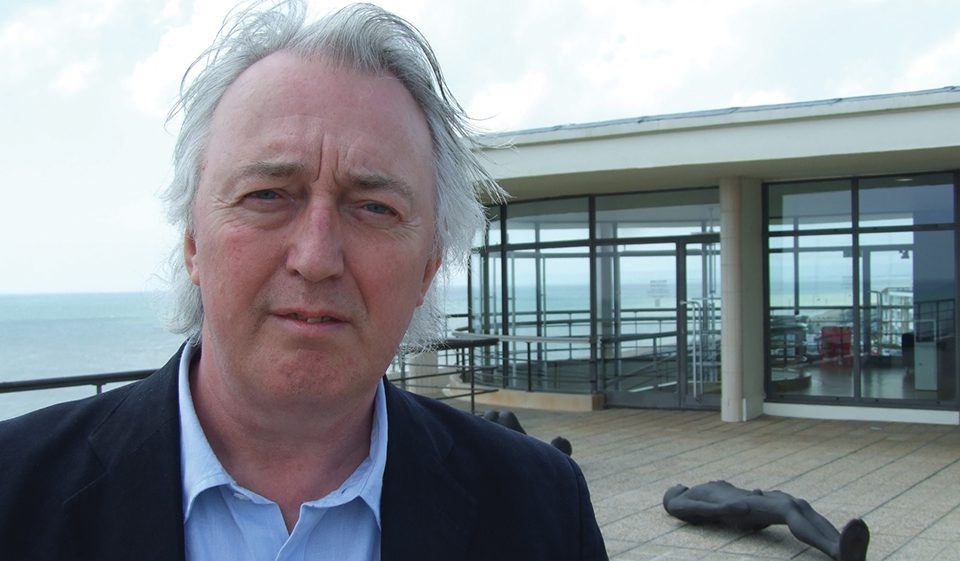Alan Haydon has been Director and Chief Executive of the De La Warr Pavilion for the past 10 years and previously, a senior visual arts manager with a number of regional and national organisations including Arts Council England, Northern Arts and London Arts Board. His philosophy is rooted in cultural democracy, enabling the freedom of arts practice to be experienced by everyone. www.dlwp.com.
DLWP had a varied exhibition programme throughout 2010 including Anthony Gormley’s Critical Mass,
what’s coming up in 2011?
In the Galleries, an equally diverse programme of new work by artists such as Catherine Yass to iconic figures of the 20th century including John Cage and Andy Warhol. We also have a unique exhibition exploring 60 years of the moving portrait, including artists Margaret Tait, Candice Breitz, Sam Taylor Wood and Julian Opie. We are working with our new resident contemporary music ensemble, The Heritage Orchestra, on a number of artist and composer collaborations. Our Rooftop Commission for 2011 will be as spectacular as the Anthony Gormley installation was this summer and will aim to attract a similar number of people – we counted 45,000.
How does your current programme reflect the ways in which visual arts are evolving to include more film and sound?
In the continuing spirit of modernity, we have tried to capture the convergent nature of contemporary culture so that the spaces between conventional notions of art, film, sound and music are creatively blurred around the edges. Our task is to allow artists to work within those spaces and to build bridges for audiences to cross. The means by which we do this often depend upon long -term relationships with artists and creating the right environment in which new ideas can be tested and in some cases, where collaborations can become creative marriages.
Being an internationally recognised gallery outside of the capital, how does this impact upon your curatorial freedom, and on the programme in general?
In many respects, our curatorial freedom is stronger, as the programme needs to demonstrate a clear sense of identity and uniqueness beyond what is commonly experienced in the metropolis. For artists as well as audiences, it is about challenging the stereotype and the perception that “the capital knows best.” In some cases, it doesn’t.
Can you comment on the trend of galleries / museums using architecture as a means to attract visitors? How does this come into play at DLWP?
Having good architecture in which to place high quality work is now part of the overall aesthetic experience. As custodians of an iconic building, the artistic challenge becomes far more amplified. However, I do share some concern where the form of a building dictates or indeed restricts its function, whether this is a heritage project or new build.
With the recent cuts in public funding, what challenges face the sector?
The sector will have to think way beyond the notion of a “savings exercise” and some hard decisions will need to be made over the next year in order to avoid a “misery for all” scenario in which the sector as a whole drags itself into a state of cultural recession. Arts Council England has taken some bold steps of late and the sector must equally respond with new ideas and new ways of sustaining its world class status.
How will galleries prosper and thrive in the new cultural landscape ahead?
In two ways. Firstly, by capturing the moment of change within the cultural landscape itself, where both artists and audiences are seeking new ways of making and consuming art beyond or in addition to the walls of the formal gallery. The digital arena presents a great new platform for this to happen. Secondly, by working collectively to make the sector stronger in its local, national and international profile and be more resilient to the changing economy. For me, prosperity is best measured by the work we enable and the audiences we engage.
From where you’re looking, what are the key opportunities?
We are looking at opportunities, which place the Pavilion within a wider international network associated not only with visual art, but also platforms of convergence into sound and music. We are also working in partnership with our sector colleagues to identify opportunities where shared resources can deliver new income streams and economies without losing sight of our independence and identity.
How do you think the role / position of the contemporary art gallery has changed over the last decade?
As a result of new capital investment triggered by Lottery funding, we now have a very different map of gallery provision that gives so many more people across the country access to and engagement with contemporary art. Galleries, museums and arts centres across the country have become the new drivers in the regeneration game and the return on the investment is social, economic as well as cultural. This is most apparent around the South East coast with initiatives such as Towner in Eastbourne, ourselves in Bexhill, Jerwood in Hastings, Triennial in Folkestone and Turner Contemporary in Margate
What are your future plans?
To neither rest on the laurels of the success of recent years nor hibernate during a lean funding climate, but to set some new ambitions that will influence the next 75 years of the Pavilion’s rich history.




